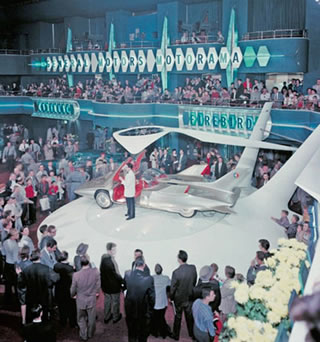Adventure on Wheels - Page 3
Earl's goal was to produce cars that didn't seem like assemblies of parts but unified designs. "Earl wanted smooth, flowing lines, with exterior parts 'built in' to the design, blending with the whole," historian Peter Grist observed.
His department grew to more than 200 artists, clay modelers, and others, and inspired other auto companies to follow suit.
The slow-talking, fast-driving Earl was attuned to advanced design in every field. When it was time to design the General Motors Technical Center, he called on the modernist architect Eero Saarinen. And when Earl sat, it was in a Mies van der Rohe chair.
 |
|
|
Not every Earl design panned out. His 1929 'pregnant Buick,' so called, according to the 'Los Angeles Times' in 1963, because of "the most tentative suggestion of a bulge between its waistline and its running boards," proved a laughing stock.
To avoid such gaffes, Earl came up with a concept. Rather than go into production with cars that might prove too radical, why not build them first as concept cars?
One of his first, the streamlined 1938 Y-Job, had electrically powered windows and a convertible top, and was Earl's daily transportation for years. But concept cars really made their mark after the war, when Earl inaugurated the GM Motorama, an annual show held from 1949 to 1961.
 |
|
|
The postwar years were decisive for American cars. They started out slowly, with most mid-1940s models sticking to their 1930s roots, streamlined and bulbous. But the public was clearly primed for more exciting models, in part because so many GIs had marveled at sleek, exciting European sports cars they'd spotted overseas.
Portents of the future soon appeared. In 1946, aircraft designer William B. Stout announced his 'car of the future,' the first car made of fiberglass, that he hoped to market as 'the Scarab.'
 |
|
|
Raymond Loewy (1893-1986), the great product and graphic designer, working with car designer Virgil Exner, designed a 1947 Studebaker Avanti that integrated its fenders and hood for a modern all-in-one look.
For Preston Tucker's ill-fated independent firm, designer Alex Tremulis created the Tucker Talisman a year later, a two-toned design that looked like a shark in front and a bat behind. Philip S. Egan, another Tucker designer who helped originate the Talisman design, refined it over the next several years.
Clearly, as the 1940s blended into the 1950s, there was a revolution underway in auto design.
"There was a quantum leap in design starting about 1948," says Dan Dunn, director of the Blackhawk Museum, an auto museum in the East Bay community of Danville. That was the year Earl produced the first cars with tailfins, Cadillacs naturally. He was inspired by similar structures on a P-38 fighter.
 |
|
|
California influenced Detroit car design in another significant way starting in the late 1940s—through the state's hot rod and custom car culture.
Growing tired of drab, prewar styles, young men with oxy-acetylene torches began taking their cars apart, 'chopping' them to lower the roofs, 'sectioning' them to change the cars' shape and size, and often removing chrome.
George Barris, California's 'King of the Kustomizers,' produced true beauties, including his Golden Sahara from 1954, with paired golden-bullet bumpers and side windows that flipped up to open.
"Detroit was paying attention to what guys like George Barris were doing," says Chris Brown of the Petersen Museum. "'Hey, we have to make our cars longer and lower.'"




